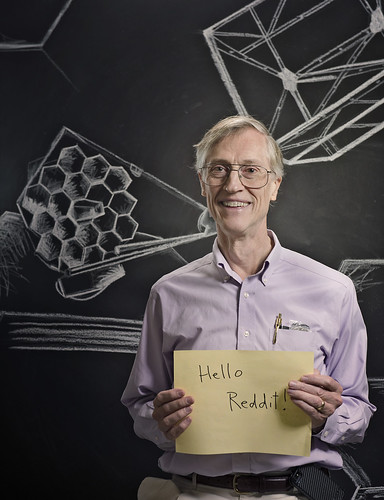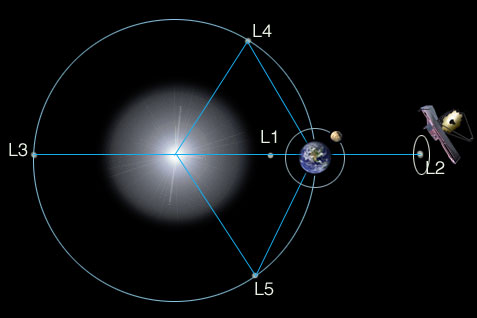Reddit Asked, John Mather Answered
- By Maggie Masetti
- November 29, 2012
- Comments Off on Reddit Asked, John Mather Answered
On Monday, November 26, 2012, Nobel Laureate and James Webb Space Telescope project scientist spent about an hour answering questions on Reddit.
You can go read the full “Ask Me Anything” thread and the interesting discussion it provoked, but we’ve pulled out some of the questions he directly answered here (thanks to Reddit for compiling a handy table of all of them). Enjoy!
(We actually interviewed John Mather for our podcast twice. We talked to him about what makes data beautiful and we also found out what his Nobel experience was like… and held our own mini-award show.)

Credit: NASA/Chris Gunn
Q: What is more likely to be the limiting factor on JWST’s service life: fuel for station-keeping, or liquid gases for cooling? If JWST runs out of coolants first, is an extended “warm mission” possible? (asked by gwray42)
A: JWST has no liquid gases for cooling. Our early design had solid hydrogen instead, but we’ve replace that with a closed-cycle refrigerator using helium gas sealed into the equipment. So, fuel for station-keeping is the limiting factor. By the way we also use the fuel for countering the built-up torque due to solar photon pressure on the sunshield.
Q: Once launched, how long will it take for JWST to arrive on-station? Once there, how much time will be required for calibration, etc., before JWST’s science can begin? (gwray42)
A: JWST arrives around L2 in 2 months, which is about the same time it takes to cool down to operating temperature. We are expecting to be in routine science observing mode 6 months after launch.
Q: What’s the next “big step” in terms of space research, after landing curiosity on Mars? (Hildingding)
A: Good question! The James Webb Space Telescope is the next big thing in astrophysics, and the Decadal survey produced by the National Academy of Sciences says the next thing after that should be the WFIRST, an wide field infrared survey telescope. Now that the NRO has donated 2 sets of optics to NASA, perhaps one set will become WFIRST. We also have in mind plans for the next great X-ray observatory, and a search for gravitational waves using a space interferometer. I think we have at least a century of amazing ideas to carry out.
Q: What is, in your opinion, the most commonly-held misconception people have about planets, stars and outer space? (TooLazyToRepost)
A: I think people have a really hard time grasping how empty outer space is, in the sense of immense distances between objects, and immense time spent going from one to another. There’s a lot of talk about space aliens as though it were physically possible for them to get here from somewhere else, and (sorry to say this) talk about human travel out of the solar system. We just don’t live long enough to do that.
Q: What do you think is the most exciting thing that the JWST can show to us? what can it help to prove / disprove that we have never had the chance to test before? (arrongunner)
A: I think JWST can produce stunning surprises in many areas. We don’t know how galaxies formed or when, we don’t know how they got supermassive black holes in their centers, we don’t know whether the black holes caused the galaxies to form or vice versa. We can’t see inside dust clouds where stars and planets are being born nearby, but JWST will be able to do just that. We don’t know how many planetary systems might be hospitable to life, but JWST could tell whether some Earth-like planets have enough water to have oceans. We don’t know much about dark matter or dark energy, but we are expecting to learn more about where the dark matter is now, and we hope to learn the history of the acceleration of the universe that we attribute to dark energy. And then, there are the surprises we can’t imagine!

Credit: NASA
Q: Of all the different scientific fields, why did you choose physics? (midnightsunrise)
A: It was the one with the greatest unsolved problems! When I was a student, we didn’t know much about the elementary particles, but we had a chance to learn so much. Then, it turned out I had a good mind for physics and math, and it was a lot of fun learning how to think about the mysteries, like relativity and quantum mechanics.
Q: Did your Nobel Prize-winning work come about by accident, or did you set out to find exactly what you found? (midnightsunrise)
A: The Nobel work came by a roundabout path. My thesis project at Berkeley was chosen because it was exciting and I liked the professors. Then it failed to function and I thought I would give up on the cosmic microwave background radiation. Then, I was a postdoc doing radio astronomy and NASA asked for satellite proposals; that was 1974. I said, my thesis project failed, but it should have been done in outer space. So we wrote a proposal and it was chosen.
Q: Along those same lines, what was the moment like when you realized, “Wow, I may actually win a Nobel Prize someday”? Or was it a surprise?(midnightsunrise)
A: About the Nobel, a lot of people thought the COBE was Nobel-quality work, but I thought, the competition is fierce, and only people like Einstein get on the list. So it was a lovely surprise!

Nobel Laureate John C. Mather shows some of the earliest data from the NASA Cosmic Background Explorer (COBE) Satellite during a press conference held at the NASA Headquarters in Washington, DC, USA. Credit: NASA/Bill Ingalls
Q: How difficult will it be for this telescope to remain at the Lagrangian2 Sun-Earth position? When will it be no longer sustainable to be at the L2 point? I heard it’s like trying to balance a marble on a horse saddle. (Insuranceisboring)
A: The L2 point: it’s unstable, but not very. We need to provide rocket force to achieve an acceleration of a few meters per second, per year! So basically the middle of that horse saddle is pretty darned flat. We have to fire the jets every few weeks, just for a short time.

Credit: NASA
Q: Why is “looking at the stars” a scientifically meaningful thing to do? (carm3n)
A: Looking at the stars was the beginning of quantitative science, and still propels new advances in technology as well as fundamental discoveries about our history and our place in the universe. People want to know how we got here, are we alone, and where we are going. Astronomy answers part of that.
Q: Where – outside of the world of science – do you draw inspiration from? (akoronakis)
A: I think history. I know just enough to see the tremendous rate of progress since Archimedes, and I’m eager to see what the next discovery is every day. I also think a bit about human organizations, since science is such a social enterprise. If you read Darwin’s Origin of Species, a lot of the text is about thanking people for helping him get information. So scientists have been social since the beginning.
Q: Dr. Mather, What do you see as the real world benefits from all the amazing research and groundbreaking discoveries in the world of physics today? (To include exoplanets, dark matter, particle physics, etc) Have you ever desired to go to space and spend time at the ISS (or further)? (timdallen)
A: Physics research underlies the progress in almost every area of science, from chemistry to biology to electronics to medicine, and physicists defined the html code for the Internet as we know it. You want to see tumors in your body, try tools from physics. You want to see better, try laser surgery using the math that we astronomers invented to see better on the ground and in space. You want to see oil reserves underground, use sound waves and the math that physicists invented.
Then of course there is the cultural benefit of understanding who we are and where we could go if we try.
Q: Will the JWST give us VISIBLE spectrum pictures to view like the Hubble? (pointmanzero)
A: Yup! JWST coverage begins at 0.6 microns wavelength, which is visible. So some of our pictures may resemble the Hubble pictures, only with different details. Our great hope is to see something completely different from what we can imagine today.


